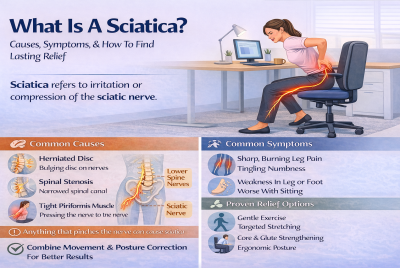Sciatica Treatment Options
Discover effective sciatica treatment options to relieve pain and restore mobility. Explore non-surgical and surgical methods tailored to you.
Understanding Sciatica and Its Treatment Options
Living with sciatica can be a daunting experience, especially when you’re trying to figure out the best treatment options. I’ve been there, so I understand how overwhelming it can be to navigate through all the advice and recommendations out there. In this article, I’ll walk you through the various sciatica treatment options, explaining each one and why it might be right for you.
What is Sciatica?
Before diving into treatment options, it’s crucial to understand what sciatica is. Sciatica refers to pain that radiates along the path of the sciatic nerve, which branches from your lower back through your hips and buttocks and down each leg. This condition occurs when the sciatic nerve is compressed, leading to pain, inflammation, and sometimes numbness in the affected leg.
Causes of Sciatica
Sciatica is usually a symptom of an underlying medical condition. Some common causes include a herniated disk, spinal stenosis, or a bone spur on the spine. These issues can put pressure on the sciatic nerve, triggering the painful symptoms associated with sciatica.
Symptoms of Sciatica
The most common symptom of sciatica is a sharp, shooting pain that travels from your lower back down to your leg. Other symptoms may include numbness, tingling, or muscle weakness in the affected leg. The pain can vary in intensity and may worsen with prolonged sitting, standing, or sudden movements.
When Should You Seek Treatment?
It’s natural to wonder whether you should seek treatment for sciatica right away or wait it out. While some cases of sciatica may resolve on their own, it’s important to recognize when professional help is necessary.
Recognizing Severe Symptoms
If you’re experiencing severe pain that disrupts your daily activities, it’s time to seek treatment. Additionally, if you notice symptoms such as loss of bladder or bowel control, significant weakness in your leg, or if the pain is sudden and severe, these could be signs of a more serious condition requiring immediate medical attention.
The Importance of Early Intervention
The earlier you address sciatica, the better your chances of preventing long-term damage. Early intervention can help reduce pain, restore mobility, and prevent the condition from worsening. Don’t wait too long to seek help—your body will thank you!
Understanding Your Sciatica Treatment Options
Non-Surgical Sciatica Treatment Options
For many people, non-surgical treatment options are the first line of defense against sciatica. These methods can be highly effective, especially when combined with lifestyle changes and other therapies.
Over-the-Counter Pain Relief
One of the most common ways to manage sciatica pain is by using over-the-counter (OTC) pain relievers.
NSAIDs (Non-Steroidal Anti-Inflammatory Drugs)
NSAIDs, such as ibuprofen or aspirin, can help reduce inflammation and alleviate pain. They’re often recommended for mild to moderate sciatica pain and can be taken as needed. However, it’s important to follow the dosage instructions to avoid any side effects.
Muscle Relaxants
If your sciatica is accompanied by muscle spasms, a muscle relaxant might be a good option. These medications work by reducing muscle tension, which can help relieve the pressure on the sciatic nerve.
Physical Therapy
Physical therapy is another cornerstone of non-surgical sciatica treatment. A physical therapist can design a program tailored to your specific needs, focusing on exercises that target the root cause of your pain.
Stretching Exercises
Stretching exercises can help alleviate the pressure on the sciatic nerve by improving flexibility and reducing muscle tightness. Common stretches include the hamstring stretch, piriformis stretch, and the child’s pose.
Strengthening Exercises
In addition to stretching, strengthening exercises are crucial for stabilizing your core and lower back muscles. A strong core can help support your spine and reduce the risk of future sciatica flare-ups.
Lifestyle Modifications
Sometimes, simple lifestyle changes can make a significant difference in managing sciatica. These adjustments can help you avoid activities or habits that might aggravate your condition.
Posture Correction
Maintaining proper posture is key to preventing and alleviating sciatica pain. Whether you’re sitting at a desk or standing for long periods, be mindful of your posture. Consider using ergonomic chairs or standing desks to reduce strain on your lower back.
Weight Management
Carrying excess weight can put additional pressure on your lower back and sciatic nerve. If weight is a contributing factor, adopting a healthy diet and exercise routine can help you shed those extra pounds and relieve your sciatica symptoms.
Alternative Therapies
If conventional treatments aren’t providing the relief you need, you might want to explore alternative therapies. These methods can be used alongside other treatments for a more holistic approach.
Acupuncture
Acupuncture, an ancient Chinese practice, involves inserting thin needles into specific points on the body to stimulate healing and relieve pain. Some people find acupuncture helpful in reducing sciatica pain, though it’s important to consult with a licensed practitioner.
Chiropractic Care
Chiropractors use spinal adjustments to correct misalignments in the spine that may be contributing to sciatica. This hands-on treatment can provide relief by improving spinal function and reducing nerve irritation.
Hot and Cold Therapy
Hot and cold therapy is a simple yet effective way to manage sciatica pain. Knowing when to use heat and when to use cold can make a big difference in your comfort level.
When to Use Heat
Applying heat to the affected area can help relax tight muscles and increase blood flow, promoting healing. Heat is typically more effective for chronic pain or stiffness.
When to Use Cold
Cold therapy, on the other hand, is best used during the acute phase of sciatica when inflammation is at its peak. Applying a cold pack can help reduce swelling and numb the pain.
Surgical Sciatica Treatment Options
In some cases, non-surgical treatments may not be enough, and surgery might be necessary to relieve the pressure on the sciatic nerve.
When is Surgery Necessary?
Surgery is usually considered a last resort when other treatments have failed or if you’re experiencing severe symptoms that require immediate intervention.
Indicators for Surgical Intervention
You might be a candidate for surgery if your sciatica pain is persistent and debilitating or if you’re experiencing significant leg weakness, loss of bowel or bladder control, or other neurological issues.
Types of Surgical Procedures
If surgery is recommended, it’s important to understand the different options available. Two common procedures for treating sciatica are microdiscectomy and laminectomy.
Microdiscectomy
A microdiscectomy involves removing a small portion of the herniated disk that’s pressing on the sciatic nerve. This minimally invasive procedure can provide quick relief from pain and has a relatively short recovery time.
Laminectomy
A laminectomy involves removing part of the vertebra called the lamina to create more space for the spinal cord and nerves. This procedure is often recommended for those with spinal stenosis causing sciatica.
Choosing the Right Sciatica Treatment for You
With so many treatment options available, it’s essential to find the one that’s right for you. This decision should be based on your specific symptoms and medical history.
Assessing Your Symptoms
Start by assessing the severity of your symptoms. Is your pain mild and manageable, or is it severe and limiting your daily activities? Understanding your pain level will help you choose the most appropriate treatment.
Mild vs. Severe Pain
For mild pain, non-surgical treatments like physical therapy, OTC pain relievers, and lifestyle changes may be sufficient. However, if your pain is severe or worsening, you may need to consider more aggressive treatments, including surgery.
Consulting with a Healthcare Professional
Before starting any treatment, it’s crucial to consult with a healthcare professional. They can help you navigate your options and develop a personalized treatment plan that addresses your unique needs.
Importance of a Tailored Treatment Plan
A tailored treatment plan takes into account your overall health, the severity of your sciatica, and your personal preferences. By working closely with your healthcare provider, you can ensure that you’re taking the right steps towards recovery.
FAQs Related to Sciatica Treatment Options
What is the fastest way to cure sciatica?
The fastest way to alleviate sciatica typically involves a combination of rest, physical therapy, and over-the-counter pain relief. However, the effectiveness of treatments varies from person to person.
Can sciatica go away on its own?
Yes, sciatica can sometimes resolve on its own, especially if the underlying cause is not severe. However, it’s important to monitor your symptoms and seek treatment if they persist or worsen.
How long does it take for sciatica to heal?
Recovery time can vary depending on the severity of your condition and the treatment approach. Mild cases may resolve within a few weeks, while more severe cases could take several months.
What is the best sleeping position for sciatica?
Sleeping on your back with a pillow under your knees or on your side with a pillow between your knees can help relieve sciatica pain by reducing pressure on your lower back.
Are there any long-term effects of untreated sciatica?
If left untreated, sciatica can lead to permanent nerve damage, chronic pain, and mobility issues. It’s important to address the condition early to prevent long-term complications.
Can I exercise with sciatica?
Yes, but it’s important to choose exercises that won’t aggravate your condition. Low-impact activities like swimming, walking, and specific stretching exercises are often recommended.
Sciatica Treatment Options – Conclusion
Dealing with sciatica can be challenging, but the good news is that there are many treatment options available to help you manage the pain and get back to living your life. Whether you opt for non-surgical treatments or need to consider surgery, the key is to take action early and work closely with your healthcare provider to find the best solution for you.
Disclaimer
This article is for informational purposes only and is not a substitute for professional medical advice, diagnosis, or treatment. Always consult with your healthcare provider before starting a new exercise or stretching routine, especially if you have existing back or nerve conditions.
👉 Explore more:
- Benefits of Physical Therapy for Sciatica
- Sciatica Pain Relief During Pregnancy
- Foods to Eat for Sciatica





